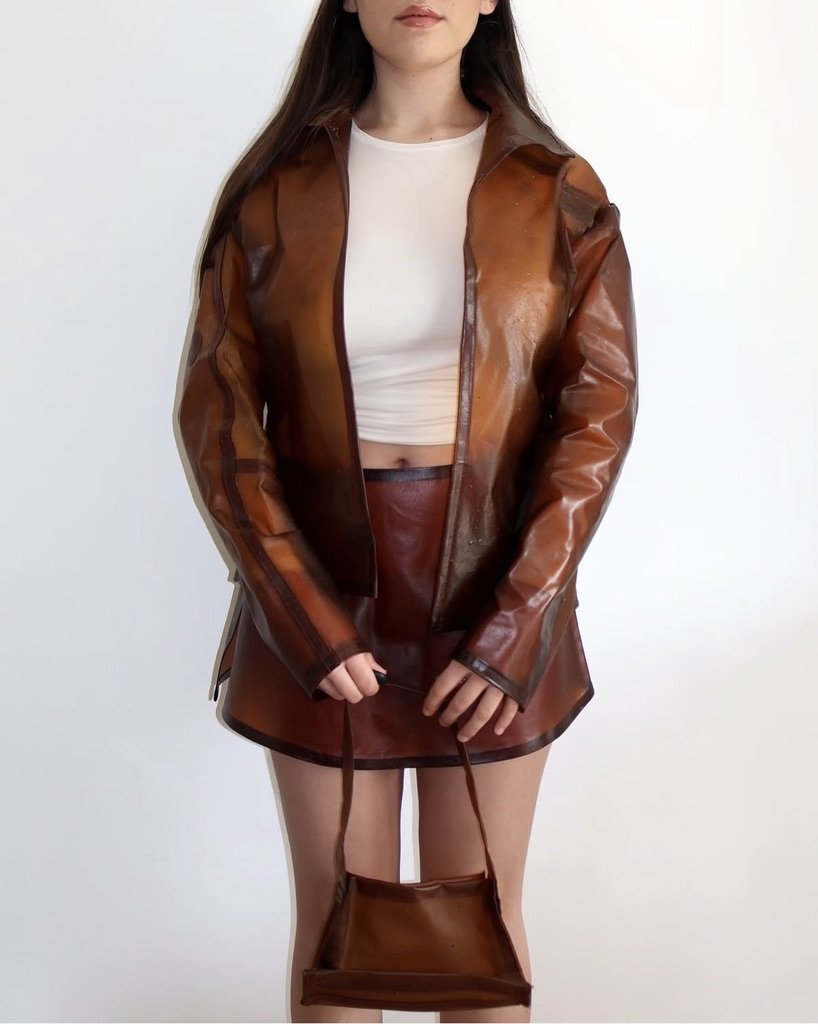The Rise of Biodegradable Couture & High-Vibration Living
The world is awakening to deeper consciousness: we’re no longer just asking what we wear — but how it feels energetically, how it was made, and what vibration it holds.
At Koldenfruit, we believe clothing is not just fabric — it’s frequency.
A clothing revolution is taking root, one fruit peel at a time.
Crafting Wearable Art from Nature's Bounty
Meet Romane Poret:
This young French designer is redefining wearable art by transforming discarded fruits and vegetables into bioplastic clothes.
Inspired by Margaret Dunne's Bioplastic Cookbook, she repurposes mango peels, beetroot skins, and orange rinds into flexible materials that become jackets, ties, and other garments.
Romane wearing her beetroot jacket creation.
Her creations are not mass-produced and all quite unique: they look like seaweed, shimmer like beetroot, and breathe with the earth’s memory.
We alter our own energy field with the energetic imprint of the clothes we wear: Our skin, our body’s largest organ, absorbs the frequencies of synthetics, plastic-based fabrics, or chemically dyed clothes. That’s why natural, biodegradable clothing holds such power — high vibration can improve our life by unlocking DNA quality, and help regenerate the essence of our aura.
Clothes made from fruit fibres are not only biodegradable, they are also a metamorphosing way to consume:
Imagine a mango that was meant to be discarded and got transformed, restored into the jacket you now carry on your shoulders — a true spiritual reconnection with the earth.
What are bio plastics?
Bioplastics are biodegradable materials made from discarded fruits and vegetables. They are an eco-friendly alternative to reduce plastics.
These sustainable fabrics can be created from different types of fruit skins, seeds and pulps; Typically, they undergo hydrolysis or processing to derive and alter their natural polymers (e. g. , pectin, cellulose found in fruits). The resulting materials are then shaped into bioplastic films or assorted forms through techniques like casting or molding.
Benefits of Fruity Bioplastics:
This methodology mais goal is to tackle ecological issues by providing an eco-conscious alternative to traditional plastics while diminishing food waste. Certain bioplastics can also be recycled or reused, further enhancing a circular economy.
We salute the genius of bio-innovators exploring the versatility of bio plastics and other uses such as packaging, furniture cover, and various other uses.
Innovators in Sustainable Textiles
Other visionary are also redefining sustainable fashion:
Fruitleather Rotterdam turning leftover mangoes into durable leather alternatives, merging innovation with environmental consciousness.
Ananas Anam (Piñatex) utilizes pineapple leaf fibers to create a versatile, leather-like material, offering a sustainable option for fashion and upholstery.
Desserto crafts cactus-based leather, providing a biodegradable and cruelty-free alternative to traditional leather.
Philippe Starck collaborated with Cassina on a 16 pieces collection of furniture upholstered in "Apple Ten Lork," a vegan fabric made from apple cores and skins. This experimental project, called "Cassina Croque La Pomme," explores alternative materials for furniture and challenges traditional leather upholstery.
Embracing High-Vibrational Living
At Koldenfruit, we are committed to curating experiences and products that elevate your lifestyle.
From biodegradable fashion to sustainable wellness products, our offerings are designed to harmonize with your inner frequency and the world around you.
Which Chakra Does This Blog Speak To Most?
This piece connects most powerfully with the Third Eye Chakra (Ajna).
✨ Why? Because it invites vision beyond the material—seeing the future of fashion, tapping into conscious consumption, intuition, and aligned values.
🌌 It’s about perception, awareness, and connecting to the bigger picture: a world where our clothes, skin, and energy are in balance.







